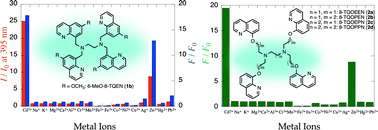In order to exploit the untapped sensing potential of the TQEN (N,N,N′,N′-tetrakis(2-quinolylmethyl)ethylenediamine) family of fluorescent probes, 8-TQEN (N,N,N′,N′-tetrakis(8-quinolylmethyl)ethylenediamine) analogs were designed and characterized. Although 8-TQEN lacks practicality owing to poor solubility in both aqueous media and organic solvents, 6-MeO-8-TQEN (N,N,N′,N′-tetrakis(6-methoxy-8-quinolylmethyl)ethylenediamine, 1b) exhibits Cd2+-selective fluorescence enhancement at 395 nm in DMF–HEPES buffer (1 : 1), (ICd/I0 = 25, λex = 332 nm, ϕCd = 0.025). Zn2+ induces weaker fluorescence (IZn/I0 = 9, IZn/ICd = 0.35). In contrast, both the parent probes TQEN (IZn/I0 = 23, ICd/IZn = 0.64) and 6-MeOTQEN (IZn/I0 = 11, ICd/IZn = 1.29 exhibit higher sensitivity toward Zn2+. When the quinoline groups were replaced with 8-hydroxyquinoline different responses were observed. The propanediamine derivative, 8-TQOEPN (N,N,N′,N′-tetrakis(8-quinolyloxyethylene)propanediamine, 2c) exhibits significant fluorescence enhancement at 423 nm upon Cd2+ binding (λex = 325 nm, ICd/I0 = 19, ϕCd = 0.31). Fluorescence enhancement is Cd2+-specific as Zn2+ induces only more modest emission increases (IZn/I0 = 8.8, IZn/ICd = 0.45).

